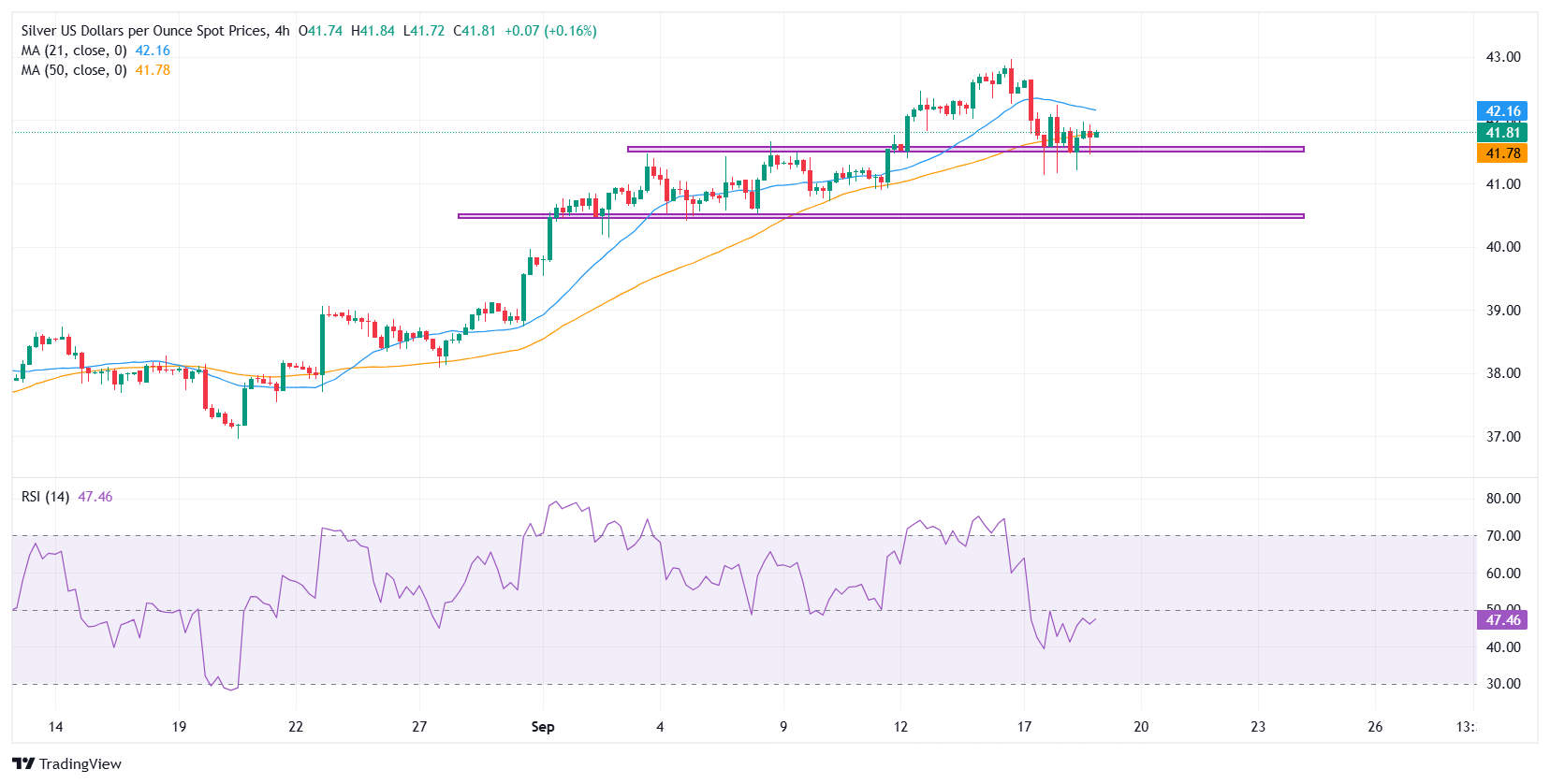- Silver rebounds modestly on Thursday, trimming intraday losses after sliding to a five-day low on Wednesday.
- Dip-buying emerges near $41.50 support, with prices hovering near the 50-period SMA.
- A breakdown below $41.50 could expose the next support base around $40.50.

Silver (XAG/USD) trims earlier intraday losses on Thursday, recovering from a five-day low marked on Wednesday in the aftermath of the Federal Reserve’s (Fed) interest rate cut decision. At the time of writing, the white metal is trading near $41.81, rebounding from an intraday trough of $41.20.
The move reflects dip-buying interest around familiar support zones, despite a firm US Dollar (USD), as broader sentiment remains cautious following a sharp pullback from record highs on Wednesday.
On the 4-hour chart, the $41.50 region has emerged as a critical support zone, highlighted by repeated lower wicks showing buyers stepping in to defend the level. Price action is currently flirting with the 50-period Simple Moving Average (SMA) at $41.78, which has aligned with this area to form a strong short-term floor. A clear break below this level could expose the next support base around $40.50.
Resistance remains layered above, with the 21-period SMA at $42.16 acting as the first barrier to recovery. A push through this level would bring $42.50 into play, followed by a potential retest of the fresh 14-year high at $42.97. A sustained break beyond that milestone could expose the psychological $43.50 handle and open the path for further gains.
The Relative Strength Index (RSI) is hovering near 47 after cooling from overbought conditions. A move back above the 50 midline would hint at renewed bullish pressure, while a drop under 45 could reinforce the case for another leg lower. For now, Silver appears locked in a range, with $41.50 providing support and the $42.00-42.20 zone capping the upside.
Silver FAQs
Silver is a precious metal highly traded among investors. It has been historically used as a store of value and a medium of exchange. Although less popular than Gold, traders may turn to Silver to diversify their investment portfolio, for its intrinsic value or as a potential hedge during high-inflation periods. Investors can buy physical Silver, in coins or in bars, or trade it through vehicles such as Exchange Traded Funds, which track its price on international markets.
Silver prices can move due to a wide range of factors. Geopolitical instability or fears of a deep recession can make Silver price escalate due to its safe-haven status, although to a lesser extent than Gold’s. As a yieldless asset, Silver tends to rise with lower interest rates. Its moves also depend on how the US Dollar (USD) behaves as the asset is priced in dollars (XAG/USD). A strong Dollar tends to keep the price of Silver at bay, whereas a weaker Dollar is likely to propel prices up. Other factors such as investment demand, mining supply – Silver is much more abundant than Gold – and recycling rates can also affect prices.
Silver is widely used in industry, particularly in sectors such as electronics or solar energy, as it has one of the highest electric conductivity of all metals – more than Copper and Gold. A surge in demand can increase prices, while a decline tends to lower them. Dynamics in the US, Chinese and Indian economies can also contribute to price swings: for the US and particularly China, their big industrial sectors use Silver in various processes; in India, consumers’ demand for the precious metal for jewellery also plays a key role in setting prices.
Silver prices tend to follow Gold’s moves. When Gold prices rise, Silver typically follows suit, as their status as safe-haven assets is similar. The Gold/Silver ratio, which shows the number of ounces of Silver needed to equal the value of one ounce of Gold, may help to determine the relative valuation between both metals. Some investors may consider a high ratio as an indicator that Silver is undervalued, or Gold is overvalued. On the contrary, a low ratio might suggest that Gold is undervalued relative to Silver.

